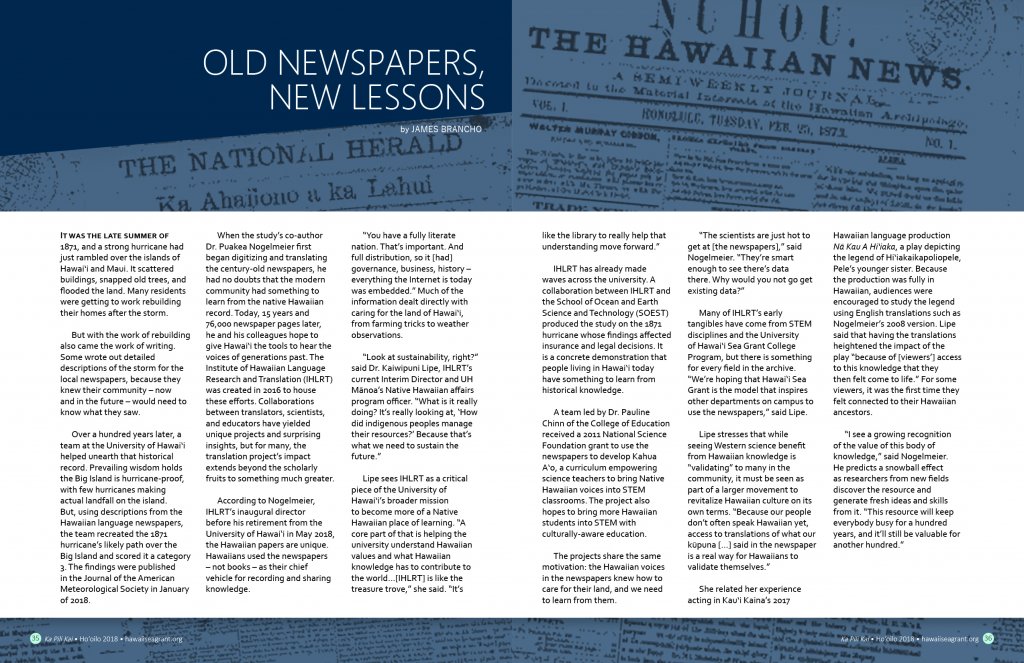It was the late summer of 1871, and a strong hurricane had just rambled over the islands of Hawaiʻi and Maui. It scattered buildings, snapped old trees, and flooded the land. Many residents were getting to work rebuilding their homes after the storm.
But with the work of rebuilding also came the work of writing. Some wrote out detailed descriptions of the storm for the local newspapers, because they knew their community – now and in the future – would need to know what they saw.
Over a hundred years later, a team at the University of Hawaiʻi helped unearth that historical record. Prevailing wisdom holds the Big Island is hurricane-proof, with few hurricanes making actual landfall on the island. But, using descriptions from the Hawaiian language newspapers, the team recreated the 1871 hurricane’s likely path over the Big Island and scored it a category 3. The findings were published in the Journal of the American Meteorological Society in January of 2018.
When the study’s co-author Dr. Puakea Nogelmeier first began digitizing and translating the century-old newspapers, he had no doubts that the modern community had something to learn from the native Hawaiian record. Today, 15 years and 76,000 newspaper pages later, he and his colleagues hope to give Hawaiʻi the tools to hear the voices of generations past. The Institute of Hawaiian Language Research and Translation (IHLRT) was created in 2016 to house these efforts. Collaborations between translators, scientists, and educators have yielded unique projects and surprising insights, but for many, the translation project’s impact extends beyond the scholarly fruits to something much greater.
According to Nogelmeier, IHLRT’s inaugural director before his retirement from the University of Hawai‘i in May 2018, the Hawaiian papers are unique. Hawaiians used the newspapers – not books – as their chief vehicle for recording and sharing knowledge.
“You have a fully literate nation. That’s important. And full distribution, so it [had] governance, business, history – everything the Internet is today was embedded.” Much of the information dealt directly with caring for the land of Hawaiʻi, from farming tricks to weather observations.
“Look at sustainability, right?” said Dr. Kaiwipuni Lipe, IHLRT’s current Interim Director and UH Mānoa’s Native Hawaiian affairs program officer. “What is it really doing? It’s really looking at, ‘How did indigenous peoples manage their resources?’ Because that’s what we need to sustain the future.”
Lipe sees IHLRT as a critical piece of the University of Hawaiʻi’s broader mission to become more of a Native Hawaiian place of learning. “A core part of that is helping the university understand Hawaiian values and what Hawaiian knowledge has to contribute to the world…[IHLRT] is like the treasure trove,” she said. “It’s
like the library to really help that understanding move forward.”
IHLRT has already made waves across the university. A collaboration between IHLRT and the School of Ocean and Earth Science and Technology (SOEST) produced the study on the 1871 hurricane whose findings affected insurance and legal decisions. It is a concrete demonstration that people living in Hawaiʻi today have something to learn from historical knowledge.
A team led by Dr. Pauline Chinn of the College of Education received a 2011 National Science Foundation grant to use the newspapers to develop Kahua Aʻo, a curriculum empowering science teachers to bring Native Hawaiian voices into STEM classrooms. The project also hopes to bring more Hawaiian students into STEM with culturally-aware education.
The projects share the same motivation: the Hawaiian voices in the newspapers knew how to care for their land, and we need to learn from them.
“The scientists are just hot to get at [the newspapers],” said Nogelmeier. “They’re smart enough to see there’s data there. Why would you not go get existing data?”
Many of IHLRT’s early tangibles have come from STEM disciplines and the University of Hawaiʻi Sea Grant College Program, but there is something for every field in the archive. “We’re hoping that Hawai‘i Sea Grant is the model that inspires other departments on campus to use the newspapers,” said Lipe.
Lipe stresses that while seeing Western science benefit from Hawaiian knowledge is “validating” to many in the community, it must be seen as part of a larger movement to revitalize Hawaiian culture on its own terms. “Because our people don’t often speak Hawaiian yet, access to translations of what our kūpuna […] said in the newspaper is a real way for Hawaiians to validate themselves.”
She related her experience acting in Kauʻi Kaina’s 2017 Hawaiian language production Nā Kau A Hiʻiaka, a play depicting the legend of Hiʻiakaikapoliopele, Pele’s younger sister. Because the production was fully in Hawaiian, audiences were encouraged to study the legend using English translations such as Nogelmeier’s 2008 version. Lipe said that having the translations heightened the impact of the play “because of [viewers’] access to this knowledge that they then felt come to life.” For some viewers, it was the first time they felt connected to their Hawaiian ancestors.
“I see a growing recognition of the value of this body of knowledge,” said Nogelmeier. He predicts a snowball effect as researchers from new fields discover the resource and generate fresh ideas and skills from it. “This resource will keep everybody busy for a hundred years, and it’ll still be valuable for another hundred.”
Browse Ka Pili Kai issues HERE


